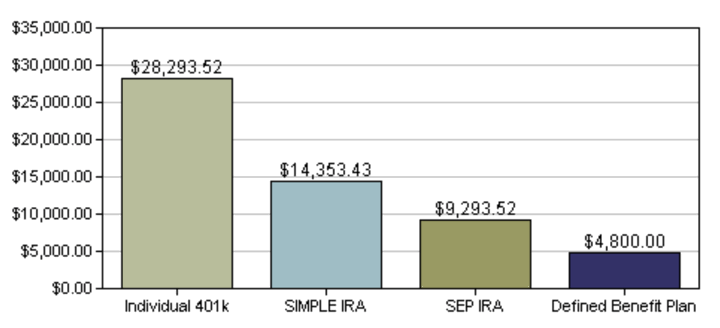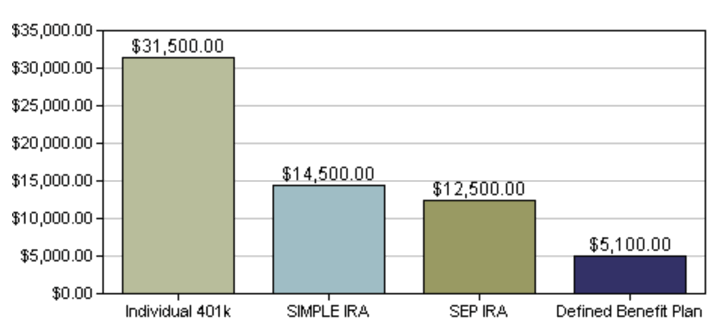 I use a Solo 401k plan because it lets you contribute the most tax-deferred money for a modest amount of self-employed income. At the end of each year, I can more clearly estimate my total income for 2019 and thus my maximum contribution limits. There are several online calculators out there (try Dinkytown or BCM Advisors), although I would cross-check your answers to make sure they agree. Your Solo 401k contribution has two components:
I use a Solo 401k plan because it lets you contribute the most tax-deferred money for a modest amount of self-employed income. At the end of each year, I can more clearly estimate my total income for 2019 and thus my maximum contribution limits. There are several online calculators out there (try Dinkytown or BCM Advisors), although I would cross-check your answers to make sure they agree. Your Solo 401k contribution has two components:
- Employee salary deferral contribution. Employees may defer up to 100% of their compensation, up to $19,000 for the 2019 tax year ($25,000 for employees age 50 or older).
- Employer profit sharing contribution. Employers may contribute up to 25% of compensation (sole proprietorships must make a special calculation), up to a combined total of $56,000 for the 2019 tax year ($62,000 if age 50 or older).
Here are some sample numbers if you are under age 50 with $50,000 in Schedule C income as an unincorporated sole proprietorship. The numbers are a bit tricky because you have to do things like take out half of the self-employment tax paid, etc. Let the calculator figure out the details, but you can still see that the Solo 401k (aka Individual 401k, aka Self-Employed 401k) offers a much higher contribution limit than a SEP IRA or SIMPLE IRA.

Here are some sample numbers if you are under age 50 had a $50,000 W-2 income from your S-Corporation. These numbers are a bit cleaner, as when you run payroll the employer side of payroll taxes are taken out of the employee paycheck.

Being able to defer up to 63% of your income ($31,500 out of $50,000) into tax-advantaged accounts is great for aggressive savers. In addition, both Traditional Pre-tax and Roth versions are allowed for the employee portion of contributions as long as your administrator supports it. Note that if you are already making employee contributions to a 401k-type plan from another job, you are still responsible for staying under the $19,000/$25,000 total cap across all your jobs. If you are consistently maxing out your 401k salary deferral in another job, then it may make more sense to stick with the SEP-IRA as it comes with less paperwork.
 The Best Credit Card Bonus Offers – 2025
The Best Credit Card Bonus Offers – 2025 Big List of Free Stocks from Brokerage Apps
Big List of Free Stocks from Brokerage Apps Best Interest Rates on Cash - 2025
Best Interest Rates on Cash - 2025 Free Credit Scores x 3 + Free Credit Monitoring
Free Credit Scores x 3 + Free Credit Monitoring Best No Fee 0% APR Balance Transfer Offers
Best No Fee 0% APR Balance Transfer Offers Little-Known Cellular Data Plans That Can Save Big Money
Little-Known Cellular Data Plans That Can Save Big Money How To Haggle Your Cable or Direct TV Bill
How To Haggle Your Cable or Direct TV Bill Big List of Free Consumer Data Reports (Credit, Rent, Work)
Big List of Free Consumer Data Reports (Credit, Rent, Work)
Thanks for this insightful article. I have two questions that I am hoping you can provide a pointer for:
1. Which provider charges minimal / zero amount for having a Solo 401K. I looked at Merill Edge and they were pretty high.
2. Second question is kind of related to first one. I will soon be at a place where I can’t make Roth IRA contributions because of income limits. So I wanted to go to the route of backdoor Roth IRA. However I rolled over my previous employer 401K to a rollover IRA at Merill and it has significant assets into it. I did this to get the preferered rewards status at BoFA. Now I am kind of regretting this move due to pro-rate issue with backdoor Roth. I was thinking of may be generating some 1099 income next year (1K or so by working in a store for a week or so or something along those lines) and then opening up a Solo 401K just to roll over the rollover IRA into solo 401K. I though Merill would be a good option to do this and by doing this I will be able to maintain by Preferred reward status as well as be able to do a backdoor roth going forward. But they charge significant fee for opening / maintaining a solo 401K.
I hope you can provide some pointers or write up an article in future that address this type of issues.
Fidelity offers a fee-free solo 401k.